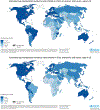Cancer Progress and Priorities: Childhood Cancer
- PMID: 32482635
- PMCID: PMC9400945
- DOI: 10.1158/1055-9965.EPI-19-0941
Cancer Progress and Priorities: Childhood Cancer
Abstract
Background:: It is estimated that 300,000 children 0-14 years of age are diagnosed with cancer worldwide each year. While the absolute risk of cancer in children is low, in high-income countries, it is the leading cause of death due to disease in children. In spite of this, the etiologies of childhood cancer are largely unknown.
Methods:: We reviewed the literature on several components of the epidemiology of childhood cancer, including incidence, survival, risk factors, etiologic heterogeneity, and prevention. After describing known patterns in the epidemiology of childhood cancer, we propose future directions for epidemiologic research.
Results:: Recent studies indicate the worldwide incidence of childhood cancer is underestimated, especially in middle- and low-income countries. While survival continues to improve, there are significant disparities across the globe. In terms of risk factors, there are a few well-established associations including race/ethnicity, birthweight, birth defects, and ionizing radiation. Identifying novel risk factors is imperative for future prevention efforts.
Conclusions:: Future epidemiologic studies of childhood cancer should incorporate novel exposure methodologies, molecular features of tumors, and a more complete assessment of gene-environment interactions.
Impact:: It is hoped that our understanding of the causes of childhood cancer can be better ascertained, leading to novel surveillance or prevention strategies.
Conflict of interest statement
Conflict of interest statement: The authors declare no conflicts of interest.
Figures




References
-
- Noone AM, Howlader N, Krapcho M, Miller D, Brest A, Yu M, et al. SEER Cancer Statistics Review, 1975-2015. Bethesda, MD: National Cancer Institute; 2017. http://seer.cancer.gov/csr/1975_2015/, based on November 2017 SEER data submission, posted to the SEER web site, April 2018.
-
- American Cancer Society. Cancer Facts and Figures, 2019. Atlanta, GA: American Cancer Society, Inc.; 2019.
Publication types
MeSH terms
Grants and funding
LinkOut - more resources
Full Text Sources
Medical

